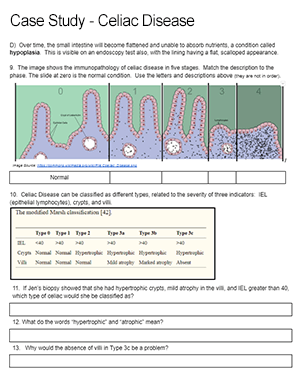
I designed this digestive system case study for my anatomy class and remote learners. The goal is for students to understand how digestion works and how an autoimmune disease (celiac) interferes with the process. I focused on specific details of the system, like villi and absorption of nutrients across the mucosa.
The case study on celiac disease can be completed independently or in small groups.
To start, this case introduces a person who was diagnosed with celiac disease and links to that person’s blog. I am fairly vague with the opening on this one, and the symptoms can describe anyone with celiac disease. After reading the introduction and symptoms, students answer questions from the text.
At this point, they will not need to look anything up unless they just need to refresh their memory on the sequence of structures in the alimentary canal. I assigned this activity after students learned about the digestive system and completed the digestive system labeling There are several challenging terms in this section, such as chronic disease, gastrointestinal, autoimmune, and malabsorption. I encourage students to use google to look up words they don’t understand.
Diagnosis and Treatment
Next, students examine photos from an endoscopy showing a normal duodenum and one from a person with celiac disease. Students learn that a blood test (serology) can detect the presence of antibodies in the blood that are known to attack tissues of the gut. They learn that a biopsy test can reveal microscopic changes in the lining of the gut. An image shows the progression of the disease and the presence of lymphocytes in the cells, as well as the changes in other cells. Over time, the villi flatten and lose their ability to absorb nutrients.
Each section is followed by questions to assess reading comprehension and understanding of the graphics. Students apply knowledge by analyzing data used to classify different types of celiac disease. On the final page, I tasked them with designing a daily meal plan that does not include gluten. Finally, students write a short summary to explain the basics of the disease to a fictional younger sister.

